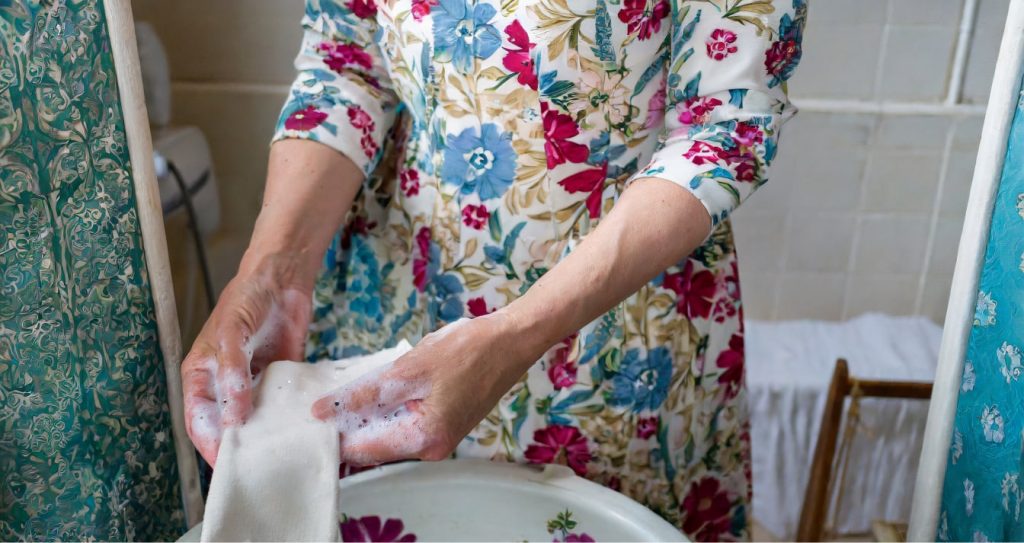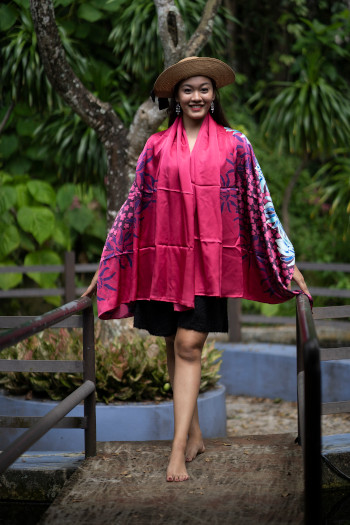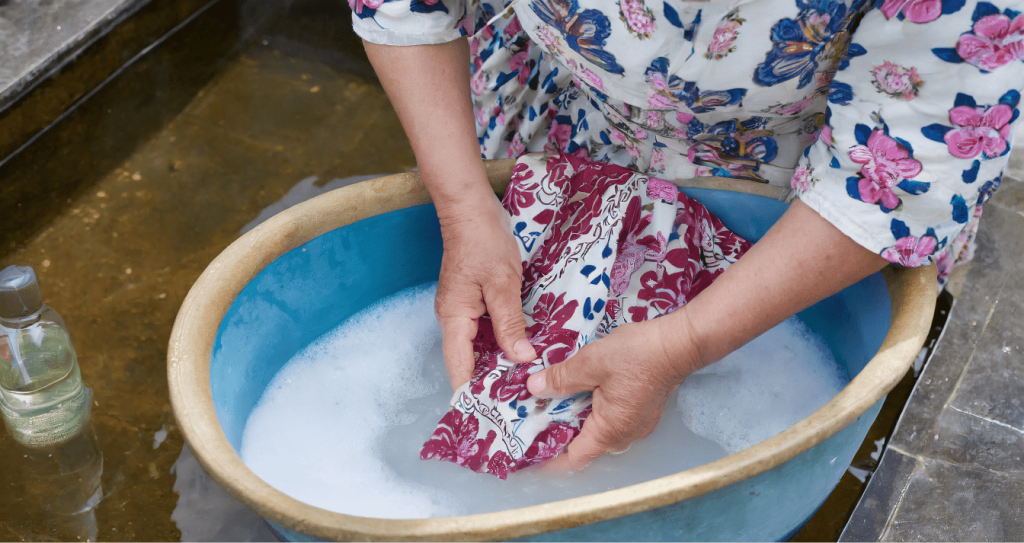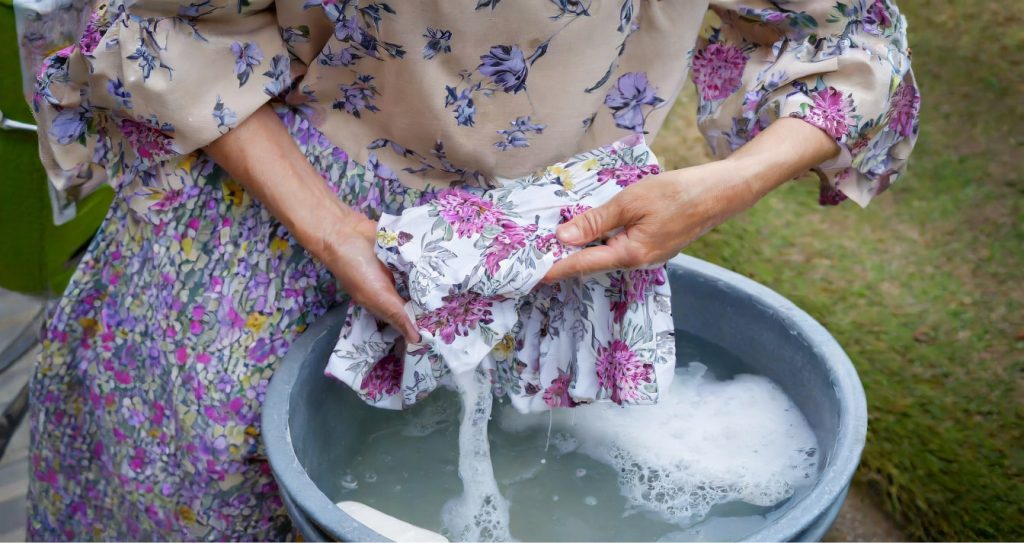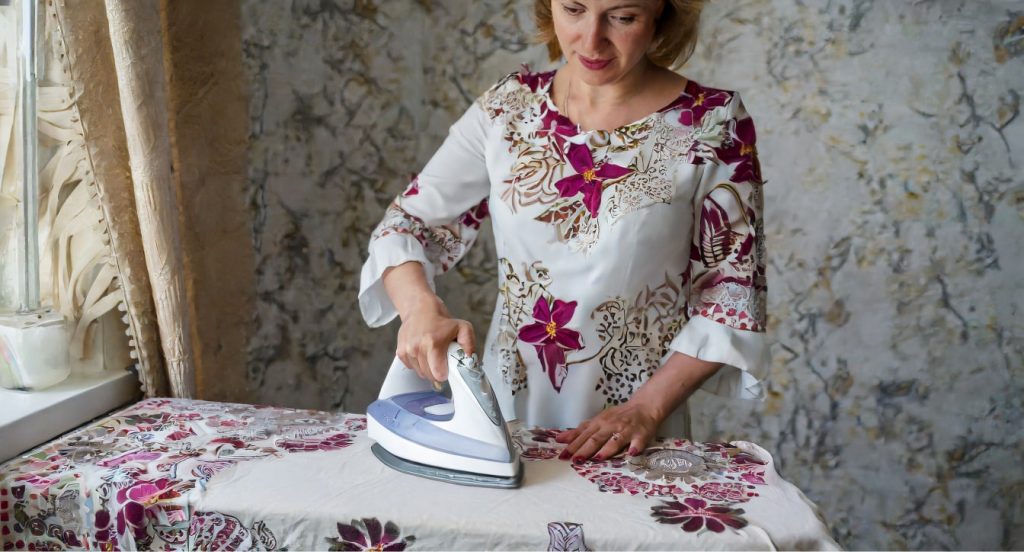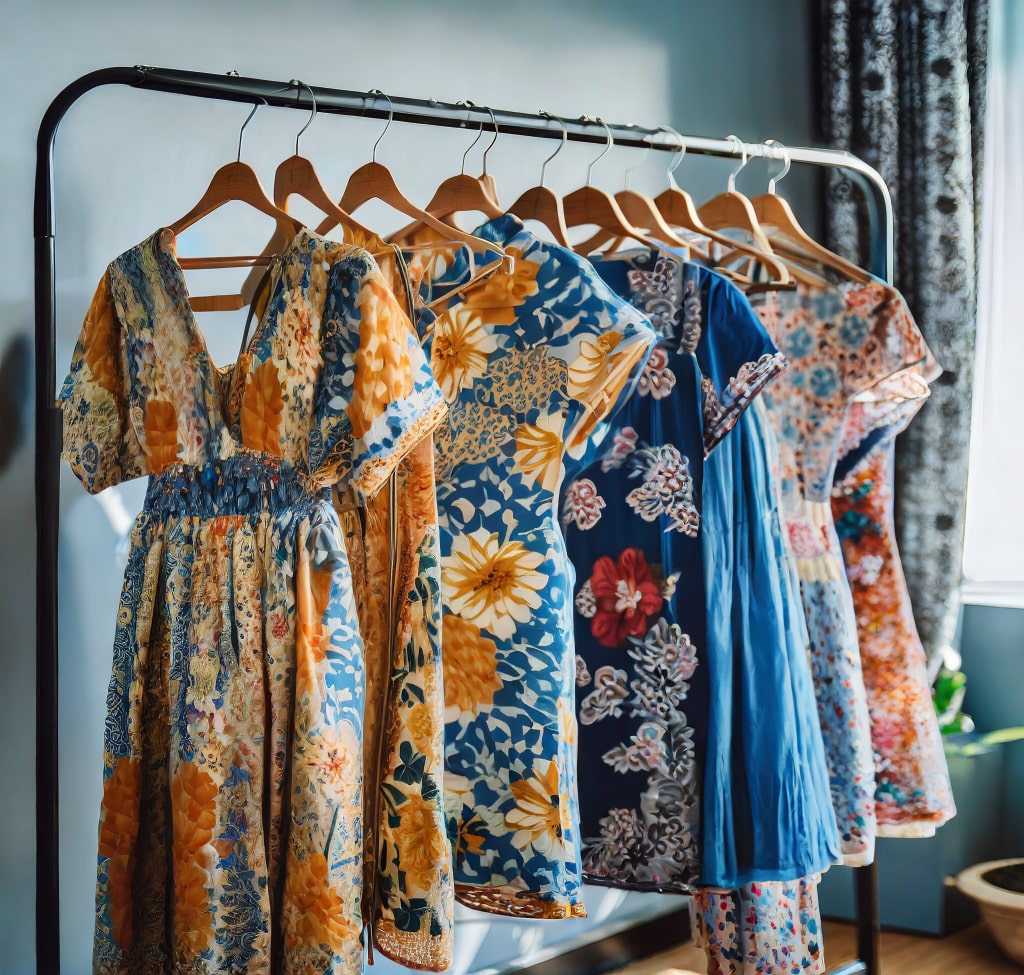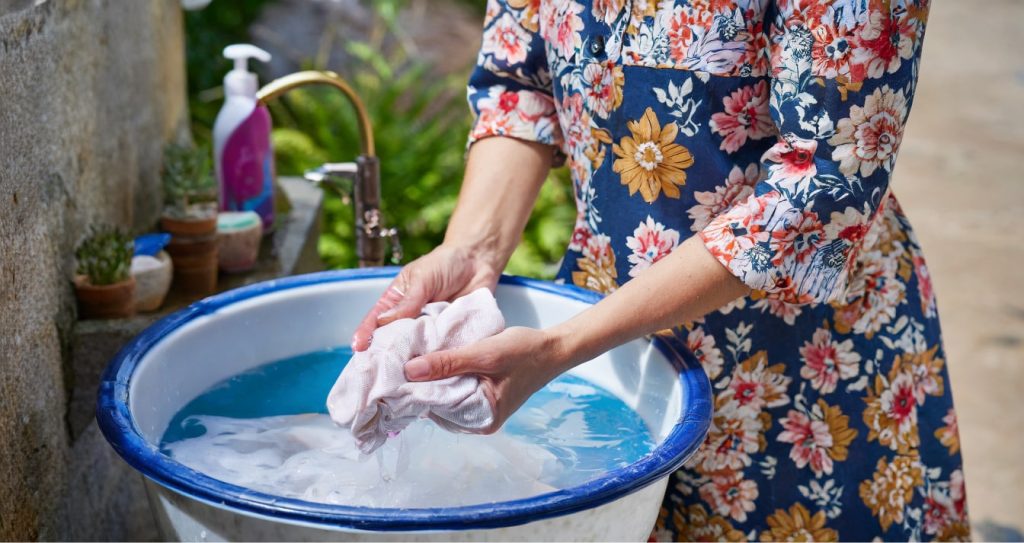
Batik dresses are not just garments; they are woven stories representing the heritage and traditions of various cultures worldwide.
From Indonesia to Malaysia, Nigeria to India, batik fabric has been cherished for centuries. But proper care is essential to appreciate and preserve these batik dresses’ beauty truly.
So if you’re eager to extend the lifespan of your beloved batik dresses and keep them looking stunning for years to come, join me on this journey.
Prewashing and Shrinking Batik Fabric
To ensure that your batik dresses maintain their quality and fit, it’s important to care for the fabric before sewing or wearing them properly. This involves prewashing the dress and taking steps to prevent future shrinkage issues.
Prewashing helps ensure colorfastness by removing any excess wax or dye that may cause bleeding. Let’s dive into these steps in more detail.
Preparing batik dress before sewing or wearing
Before you start working with your batik dresses, it’s crucial to prewash it. This step helps eliminate any residual wax or dye that might still be present on the batik fabric. To prewash your batik dress:
- Fill a basin or sink with lukewarm water.
- Gently agitate the fabric in the water for a few minutes.
- Rinse the fabric thoroughly until the water runs clear.
- Squeeze out excess water without wringing or twisting the fabric.
By prewashing your batik dress, you’ll remove any remaining wax from the production process, ensuring a clean canvas for sewing and reducing the risk of staining other garments when worn.
Shrinking techniques to prevent future shrinkage issues
Our batik dresses are made from natural fibers like satin, which can shrink when exposed to heat or moisture. To prevent future shrinkage issues after washing your batik dress:
- Test for colorfastness: Before using any shrinking technique, test a small piece of the fabric to ensure its colors won’t fade or bleed excessively.
- Steam ironing: Use a steam iron on low heat while pressing down on dampened (not wet) batik fabric to relax its fibers and minimize potential shrinkage.
- Air drying: Hang your washed batik dress flat or line dry it instead of using a dryer machine as excessive heat can cause further shrinkage.
Taking these precautions will help maintain your batik dress’s original size and shape, ensuring it fits you perfectly every time you wear it.
Ensuring colorfastness through prewashing
Prewashing your batik fabric removes wax and dye residue and helps ensure colorfastness. This means that the colors of your batik dress won’t bleed or fade when exposed to water or other fabrics. To enhance colorfastness:
- Use a mild detergent: Opt for a gentle detergent specifically designed for delicate fabrics to avoid harsh chemicals that may affect the colors.
- Wash separately: During the initial washes, wash your batik dress separately from other garments to prevent any potential bleeding onto lighter-colored items.
- Cold water wash: Stick to cold water instead of hot or warm temperatures, as heat can cause colors to fade or bleed.
By following these steps, you’ll maintain the vibrant colors of your batik dress, allowing you to enjoy its beauty for a long time.
Washing Batik Dresses: Softening and First-time Care
To keep your delicate batik dresses looking their best, it’s important to use gentle washing methods that preserve intricate designs and vibrant colors.
Softening techniques can enhance the comfort and drape of the fabric. For first-time care of new batik garments, there are special considerations to ensure they remain pristine.
Gentle Washing Methods for Delicate Batik Dresses
It’s crucial to handle them with care. Here are some gentle washing methods you can follow:
- Handwashing: To avoid any potential damage caused by a washing machine, handwashing is recommended for batik dresses. Fill a basin or sink with lukewarm water and add a mild detergent specifically designed for delicate fabrics.
- Soaking: Gently submerge the dress in the soapy water and let it soak for about 15 minutes. Avoid excessive rubbing or wringing as this can distort the fabric or cause color bleeding.
- Rinsing: After soaking, rinse the dress thoroughly with clean lukewarm water until all traces of soap are removed.
- Drying: To dry your batik dress, gently squeeze out excess water without wringing or twisting the fabric. Lay it flat on a clean towel and reshape it if necessary. Avoid direct sunlight as it may fade the colors.
Softening Techniques to Enhance Comfort and Drape
Batik dresses often have a stiff texture due to the wax-resist dyeing process used during their creation. However, there are ways to soften them for improved comfort and drape:
- Steam Ironing: Set your iron to a low heat setting suitable for delicate fabrics such as silk or rayon (check the garment label). Place a thin cloth over your batik dress before lightly steaming it with an iron held a few inches above the fabric. The steam will help relax the fibers and soften the dress.
- Fabric Softener: Another option is to add a small amount of fabric softener to your final rinse when handwashing or use a fabric softener sheet in the dryer if machine drying is recommended for your batik dress. This can help reduce stiffness and make the fabric feel softer against your skin.
Special Considerations for First-Time Washing of New Batik Garments
When you first acquire a new batik dress, it’s essential to take extra care during its initial washing to preserve its beauty and integrity:
- Separate Colors: Before washing, sort your batik dresses by color to prevent any potential color bleeding. Wash darker colors separately from lighter ones.
- Test for Colorfastness: Perform a colorfastness test on a small, inconspicuous dress area before proceeding with full washing. Dampen a cotton swab with water and gently rub it on the fabric. If any color transfers onto the swab, refrain from washing the dress as it may bleed during subsequent washes.
- Follow Care Instructions: Always refer to the garment’s care label for specific instructions the manufacturer provides. Some batik dresses may require dry cleaning instead of handwashing or machine washing.
By following these gentle washing methods, employing softening techniques, and considering special precautions for first-time care, you’ll be able to maintain the beauty and longevity of your beloved batik dresses.
Avoiding Sun Drying: Preventing Clothes from Fading
Damaging Effects of Sun Drying on Vibrant Colors
Sun drying may seem like a convenient way to dry your batik dresses, but it can have detrimental effects on the vibrant colors. The harsh UV rays from the sun can cause the dyes in the fabric to fade over time. This can result in your beautiful batik dress losing its original charm and vibrancy.
Alternatives to Sun Drying for Preserving the Integrity of Batik Dresses
Fortunately, there are alternatives to sun drying that can help preserve the integrity of your batik dresses. Here are some options you can consider:
- Shade drying: Find a shaded area, such as under a tree or an awning, where you can hang your batik dress to dry. This way, you can still take advantage of natural airflow without subjecting your garment to direct sunlight.
- Indoor drying: If you have enough space indoors, consider hanging your batik dress on a clothesline or drying rack inside your home. This will protect it from harmful UV rays while allowing it to air dry naturally.
- Use a clothes dryer: If you’re short on time and need your batik dress dried quickly, using a clothes dryer on low heat is a viable option. Just make sure to check the care label of your garment first to ensure it’s suitable for machine drying.
Tips for Air-Drying Without Compromising Color Vibrancy
If air-drying is your preferred method for caring for batik dresses, here are some tips to keep in mind while preserving color vibrancy:
- Use cold water: When washing your batik dress before air-drying, opt for cold water instead of hot or warm water. Cold water helps prevent excessive color bleeding and fading during the washing process.
- Choose a gentle detergent: Select a detergent specifically formulated for delicate garments or one that is free of harsh chemicals. This will help protect the colors and fabric of your batik dress.
- Add retayne to the wash: Retayne is a color fixative that helps set the dyes in fabric, preventing them from bleeding or fading. Follow the instructions on the product label to determine the appropriate amount to add to your wash cycle.
- Avoid wringing or twisting: After washing, gently squeeze out excess water from your batik dress without wringing or twisting it forcefully. This can cause unnecessary stress on the fabric and potentially lead to color distortion.
- Lay flat to dry: When air-drying your batik dress, lay it flat on a clean towel or drying rack instead of hanging it up. This will help maintain its shape and prevent any stretching or sagging while drying.
By following these tips and alternatives to sun drying, you can ensure that your batik dresses retain their vibrant colors for years to come.
Ironing Batik Dresses: Minimizing Fading and Brightening Techniques
Proper Ironing Temperature to Avoid Color Loss in Batik Prints
Ironing batik dresses requires some finesse to ensure that the vibrant colors of the fabric are preserved. One key factor to consider is the ironing temperature. Set your iron at a moderate heat level, neither too high nor too low.
Excessive heat can cause the colors in batik prints to fade or even bleed, resulting in a dull appearance. On the other hand, if the iron is not hot enough, it may not effectively smooth out wrinkles and creases.
To determine the appropriate temperature for your batik dress, check its care label or consult with the manufacturer’s guidelines. Different types of batik fabrics may have specific requirements regarding ironing temperatures.
If you’re unsure about the ideal setting, it’s always better to err on the side of caution and start with a lower heat setting.
Brightening Dull Areas with Strategic Ironing Techniques
Over time, certain areas of your batik dress may become duller than others due to repeated wear and washing. However, fear not! With some strategic ironing techniques, you can help restore brightness and luster to these faded spots.
One effective technique involves using steam during ironing. Fill up your iron’s water reservoir according to its instructions and switch on the steam function.
Gently hover the steam over dull areas while applying light pressure with the iron. The moisture from the steam will penetrate the fabric fibers and help revive their vibrancy.
Another method is employing an old-fashioned trick known as “iron buffing.” Place a clean cloth or paper towel over a dull area of your batik dress before running a warm iron over it.
The heat and gentle rubbing motion will create friction between the cloth/paper towel and fabric surface, effectively buffing any dullness.
Using Protective Barriers During Ironing to Prevent Direct Contact with Fabric
When ironing batik dresses, it’s crucial to protect the delicate fabric from direct contact with the iron. This can be achieved using protective barriers such as a pressing cloth or a muslin fabric.
These barriers act as a shield between the hot surface of the iron and the batik dress, preventing potential damage.
To use a pressing cloth, simply place it over the area you wish to iron and proceed with your regular ironing technique. The cloth will absorb excess heat and distribute it evenly across the fabric, minimizing the risk of color loss or scorch marks.
Similarly, if you have a piece of muslin fabric, you can cut it into smaller squares or rectangles and use them as protective pads during ironing. Just position these fabric pieces between your iron and the batik dress while applying gentle pressure.
This way, even if there are any accidental temperature fluctuations or hot spots on your iron’s surface, they won’t directly impact the delicate batik print.
By following these techniques for ironing batik dresses, you can ensure that their colors remain vibrant and their beauty is preserved for years to come.
Preventing Color Fading: Sunlight Exposure and Natural Dyes
Understanding how sunlight exposure affects natural dyes in batik fabrics
Sunlight can significantly impact the colors of batik dresses, especially those made with natural dyes. These dyes are derived from plant-based sources and are more susceptible to fading when exposed to direct sunlight for extended periods.
The ultraviolet (UV) rays in sunlight can break down the chemical bonds within the dye molecules, causing them to lose their vibrancy over time.
To prevent color fading caused by sunlight exposure, taking certain precautions when caring for your batik dresses is important.
Choosing appropriate storage options to minimize light exposure
One way to protect your batik dresses from color fading is by storing them in a dark or low-light environment. Avoid hanging them near windows or areas where they will be exposed to direct sunlight. Instead, opt for a closet or drawer with shade and minimal light exposure.
If you prefer displaying your batik dresses, consider using UV-filtering window coverings or curtains to help block harmful UV rays. This will not only preserve the vibrant colors of your dresses but also protect them from other potential damage caused by excessive sunlight.
Identifying natural dye sources that are less prone to fading
While all-natural dyes may fade over time when exposed to sunlight, some sources are known to be more resistant than others. For example, indigo dye derived from plants like Indigofera tinctoria tends to hold its color better than other natural dyes.
When purchasing or creating batik dresses, consider opting for designs that incorporate these more resilient natural dyes. This way, you can enjoy the beauty of batik fabrics while minimizing the risk of color fading due to sun exposure.
It’s important to note that synthetic dyes used in some modern batik fabrics may offer greater resistance against color fading caused by sunlight. However, if you prefer natural dyes’ traditional charm and authenticity, taking precautions to protect them from excessive sunlight exposure is essential.
Special Care for Handmade Batik Dresses
Our batik dresses are all handmade with premium batik fabrics. Hence, they require delicate treatment to preserve their intricate details and ensure their longevity. Here are some tips on how to handle your batik dresses.
Precautions
- Always wash your hands before handling the garments: Make sure your hands are clean before touching your precious batik dress. This will prevent any dirt or oils from transferring onto the fabric, which could potentially damage the delicate hand-applied designs.
- Avoid excessive folding and creasing: Batik cloth is known for its beautiful patterns and motifs, which skilled artisans painstakingly create. Avoid excessive folding and creasing when storing or wearing your batik dress to maintain these intricate details. Instead, gently hang it or lay it flat to prevent unnecessary stress on the fabric.
Cleaning Methods
Cleaning a handmade batik dress requires special attention to protect its delicate hand-applied designs. Here’s how you can clean your batik dress while preserving its beauty:
- Hand-washing is the way to go: Opt for gentle hand-washing instead of tossing it in the washing machine. Fill a basin with lukewarm water and a mild detergent specifically designed for delicate fabrics.
- Use color catchers: To prevent colors from bleeding or fading during the washing process, add color catchers to the water along with your batik dress. These handy products absorb any excess dye released during washing, ensuring your vibrant colors stay intact.
Storing Your Handmade Batik
Proper storage is crucial to maintaining the uniqueness of handmade batik dresses. Follow these tips to store your cherished pieces correctly:
- Choose an appropriate storage option: Opt for a breathable fabric garment bag or a cotton pillowcase when storing your batik dress. Avoid using plastic bags, as they can trap moisture and potentially damage the fabric.
- Keep away from direct sunlight: Sunlight can cause colors to fade over time, so it’s important to store your batik dress in a cool, dark place away from direct sunlight. This will help preserve the vibrancy of the fabric and prevent any unwanted discoloration.
Additional Recommendations for Batik Dress Care
Spot Cleaning Tips for Minor Stains on a Specific Area
So, you’ve got a beautiful batik dress, and unfortunately, it has encountered a minor stain. There are some spot-cleaning tips you can try to remove those pesky stains without washing the entire dress.
- Start by blotting the stained area gently with a clean cloth or paper towel. Avoid rubbing the stain vigorously as it may spread or damage the fabric.
- If the stain is water-soluble, you can mix a small amount of mild detergent with water and apply it to the stained area using a soft brush or sponge. Gently scrub in circular motions and rinse thoroughly.
- For oil-based stains, sprinkle some talcum powder or cornstarch on the affected area and let it sit for a few minutes. This will help absorb the oil. Then, carefully brush off the powder and repeat if necessary.
- Remember to always test any cleaning solution on a small, inconspicuous area of your batik dress before applying it to the stain directly.
Refreshing Techniques Between Washes Without Full Laundering
Sometimes your batik dress doesn’t necessarily need a full wash but could use some freshening up between wears. Here are some techniques you can try:
- Hanging your batik dress outside in fresh air can help eliminate odors and give it a quick refresh.
- If there are wrinkles on your dress, lightly steam them out using a handheld steamer or hang it in the bathroom while taking a hot shower. The steam will help relax the fabric and reduce creases.
- Another option is using fabric sprays that are specifically designed to refresh clothing between washes. Simply spray lightly onto your batik dress from a distance and allow it to dry before wearing.
Professional Cleaning Options When Necessary
When all else fails or when dealing with more stubborn stains, it may be best to seek professional cleaning services for your batik dress. Here are a few options to consider:
- Take your dress to a professional dry cleaner with experience handling delicate fabrics like batik. They have specialized equipment and knowledge to clean and preserve your dress effectively.
- If there is a specific stain that needs attention, you can also consult with a stain removal specialist who can provide targeted treatment for the stain without compromising the integrity of the fabric.
Remember, caring for your batik dress properly will help prolong its lifespan and keep it looking vibrant and beautiful. By following these additional recommendations, you’ll ensure that your batik dress stays in excellent condition for many occasions to come.
Conclusion
Congratulations! You are now equipped with the knowledge to care for your precious batik dresses and ensure their longevity. You can keep your batik dresses looking vibrant and beautiful for years to come.
Remember, caring for batik dresses is not just about maintenance; it is an act of preserving artistry and culture. Treat each dress as a masterpiece, and handle it with love and care.
Now go ahead and show off your stunning batik collection with confidence! And if you have any more questions or need further assistance in caring for your batik dresses, don’t hesitate to reach out. We’re here to help!
FAQs
Can I wash my batik dress in a washing machine?
While handwashing is recommended for most batik dresses to prevent damage or color bleeding, some machine-washable batiks may exist. Always check the care label or consult the manufacturer’s instructions before attempting machine washing.
How often should I wash my batik dress?
It is best to wash your batik dress only when necessary to minimize wear and tear. If there are no stains or odors present after wearing it once or twice, consider airing it out instead of washing it.
Can I use bleach on my stained batik dress?
Avoid using bleach on your batik dress as it can cause discoloration or damage the fabric. Instead, try using mild stain removers specifically designed for delicate fabrics.
Should I store my batik dress folded or hung?
To avoid stretching or misshaping the fabric, it is generally recommended to fold your batik dress and store it in a cool, dry place. However, if you have limited storage space, hanging it on a padded hanger can be an alternative option.
How can I remove wrinkles from my batik dress without ironing?
If you don’t have access to an iron, try hanging your batik dress in a steamy bathroom or using a handheld garment steamer. The steam will help relax the fabric and reduce wrinkles. Just be careful not to get the dress too wet in the process.

